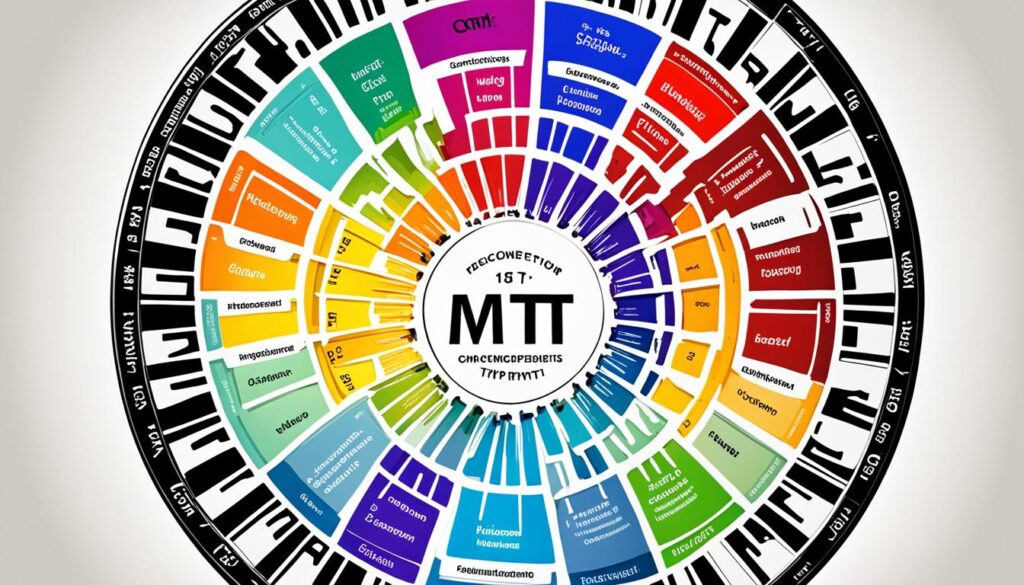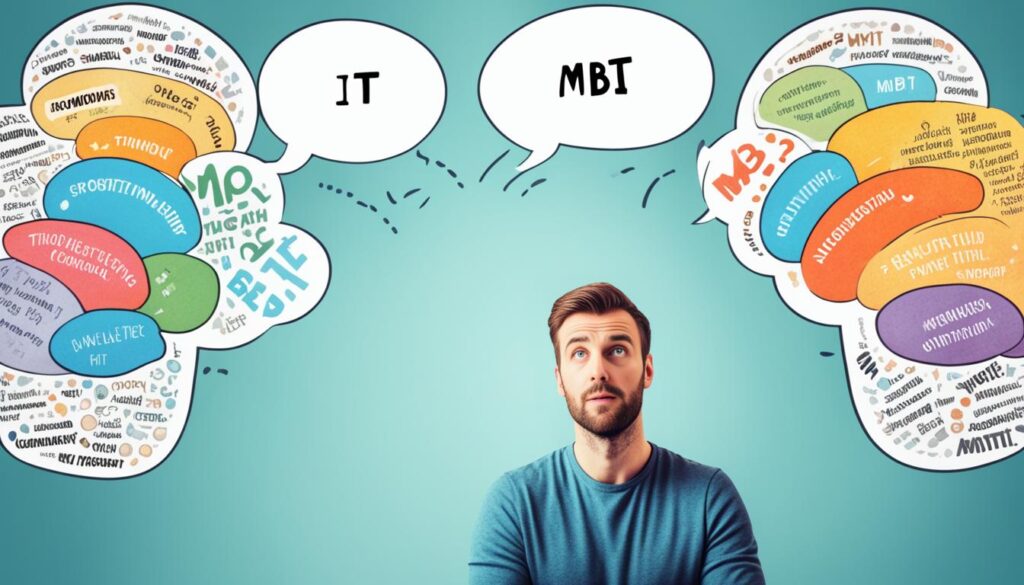Were you aware that the Myers-Briggs Type Indicator (MBTI) is utilized by more than 88% of Fortune 500 companies for recruitment and team-building endeavors? This highly respected personality assessment has become a crucial instrument in comprehending ourselves and those around us. Created on the foundation of Carl Jung’s personality type theory, the MBTI offers valuable perspectives into our inclinations, strengths, and ways of communicating.
In this article, we will delve into the fascinating world of the Myers-Briggs Type Indicator. We will explore the history of its development, the four dichotomies that form its framework, and the 16 different personality types it encompasses. Additionally, we will discuss the usefulness of the MBTI in understanding ourselves and others, as well as the criticisms and controversies surrounding it.
Key Takeaways:
- The Myers-Briggs Type Indicator (MBTI) is widely used in corporate settings, with over 88% of Fortune 500 companies utilizing it for recruitment and team-building.
- The MBTI is based on Carl Jung’s theory of personality types and provides valuable insights into individuals’ preferences, strengths, and communication styles.
- Understanding the history and framework of the MBTI can help us gain a deeper understanding of ourselves and others.
- While the MBTI has its criticisms and controversies, many people find value in using it as a tool for personal growth and improving relationships.
- Using the MBTI with an open mind and recognizing its limitations can enhance its effectiveness in various settings.
The History of the Myers-Briggs Type Indicator
The Myers-Briggs Type Indicator (MBTI) has a fascinating history that traces back to its development during World War II by Isabel Myers and Katherine Briggs. Inspired by Carl Jung’s theory of psychological types, Myers and Briggs wanted to create a tool that could help individuals understand their own personalities and make informed career choices that align with their strengths. Over the years, the inventory underwent refinements to become one of the most popular and widely used psychological assessments today.

The Four Dichotomies of the MBTI
Personality preferences are measured in the MBTI through four dichotomies. These dichotomies highlight the differences in how individuals perceive and interact with the world.
- Extraversion (E) versus Introversion (I): This dichotomy refers to where individuals direct their energy. Extraverts gain energy from external stimuli and tend to be outgoing and sociable. Introverts, on the other hand, gain energy from within themselves and are more reflective and reserved.
- Sensing (S) versus Intuition (N): This dichotomy represents how individuals gather information. Sensing types focus on concrete facts and details, relying on their five senses. Intuitive types, on the other hand, rely on patterns and abstract concepts, looking beyond the surface to see the bigger picture.
- Thinking (T) versus Feeling (F): This dichotomy reflects how individuals make decisions. Thinking types make decisions based on logic and objective analysis, prioritizing fairness and consistency. Feeling types, however, make decisions based on personal values and empathy, considering the impact on others.
- Judging (J) versus Perceiving (P): This dichotomy describes how individuals orient themselves to the outside world. Judging types prefer structure, order, and organization, seeking closure and making decisions quickly. Perceiving types, on the other hand, are more flexible and adaptable, keeping options open and enjoying spontaneity.
These dichotomies influence various aspects of our lives, including how we gain energy, gather information, make decisions, and organize our environment. By understanding these preferences, we can gain valuable insights into our own personalities and how we interact with others.

The 16 Myers-Briggs Personality Types
As we delve deeper into the Myers-Briggs Type Indicator (MBTI), we discover that it categorizes individuals into 16 different personality types based on their preferences along the four dichotomies. These 16 types provide a comprehensive framework for understanding ourselves and others, shedding light on the complexities of human personality.
Each personality type is identified by a four-letter code that represents their unique combination of preferences. Let’s take a closer look at these 16 Myers-Briggs types:
- ISTJ – Introversion, Sensing, Thinking, Judging
- ISFJ – Introversion, Sensing, Feeling, Judging
- INFJ – Introversion, Intuition, Feeling, Judging
- INTJ – Introversion, Intuition, Thinking, Judging
- ISTP – Introversion, Sensing, Thinking, Perceiving
- ISFP – Introversion, Sensing, Feeling, Perceiving
- INFP – Introversion, Intuition, Feeling, Perceiving
- INTP – Introversion, Intuition, Thinking, Perceiving
- ESTP – Extraversion, Sensing, Thinking, Perceiving
- ESFP – Extraversion, Sensing, Feeling, Perceiving
- ENFP – Extraversion, Intuition, Feeling, Perceiving
- ENTP – Extraversion, Intuition, Thinking, Perceiving
- ESTJ – Extraversion, Sensing, Thinking, Judging
- ESFJ – Extraversion, Sensing, Feeling, Judging
- ENFJ – Extraversion, Intuition, Feeling, Judging
- ENTJ – Extraversion, Intuition, Thinking, Judging
Each personality type possesses its own distinct characteristics and strengths. It is important to note that there is no “better” or “worse” type – every type contributes unique perspectives and abilities to the world.

Understanding the 16 Myers-Briggs personality types allows us to appreciate the diversity of human nature. Each type brings its individual strengths and perspectives, contributing to the rich tapestry of humanity.
The Usefulness of the MBTI in Understanding Yourself and Others
The Myers-Briggs Type Indicator (MBTI) is a valuable tool for gaining insight into our own personalities and understanding others. By identifying our strengths, weaknesses, and preferences, we can enhance our self-understanding and make more informed decisions.
The MBTI also helps us comprehend the unique qualities of those around us, leading to improved relationships and effective communication. When we recognize and appreciate different personality types, we create an environment of understanding and empathy.
Whether in school, work, or personal relationships, the MBTI can promote collaboration and teamwork. By leveraging our knowledge of personality types, we can better adapt our communication styles, resolve conflicts, and foster a harmonious and productive environment.
Understanding ourselves and others is an essential aspect of personal growth and building successful relationships. The MBTI offers a framework that aids in this endeavor by providing insights that go beyond surface-level behaviors.
Benefits of MBTI in Self-Understanding
One of the key benefits of the MBTI is its ability to help us gain a deeper understanding of ourselves. By identifying our personality type, we become aware of our natural strengths and can align our choices and career paths accordingly. This self-awareness empowers us to make informed decisions and pursue activities and professions that align with our preferences.
The MBTI also enables us to identify areas for improvement. By acknowledging our weaknesses, we can take proactive steps to develop skills and overcome challenges. This self-development journey leads to personal growth and enhances our overall well-being and satisfaction in life.
Enhancing Relationships through Understanding Others
Understanding others is key to building strong and meaningful relationships. The MBTI allows us to appreciate the differences in how individuals think, feel, and interact with the world. This understanding creates empathy and compassion, enabling us to connect with others on a deeper level.
As we gain insight into others’ personality types, we can adjust our communication style to better resonate with their preferences. This adaptability paves the way for effective and meaningful conversations, reducing misunderstandings and conflicts.
“When we strive to understand others, we forge connections that foster collaboration and growth.”
Case Study: Improving Team Dynamics at XYZ Corporation
At XYZ Corporation, the MBTI was implemented to enhance team dynamics and improve collaboration. Each team member completed the MBTI assessment, allowing them to understand their own personality types and those of their colleagues.
The results were used to form diverse teams comprising individuals with complementary strengths and preferences. This approach facilitated better communication, problem-solving, and creativity within the teams.
The table below demonstrates the distribution of personality types within the organization:
| Personality Type | Percentage |
|---|---|
| ISTJ | 18% |
| ENFP | 12% |
| INTP | 15% |
| ESFJ | 10% |
| ESTJ | 14% |
| INFP | 8% |
| ENTJ | 9% |
| Other Types | 14% |
The diverse mix of personality types resulted in innovative problem-solving, improved team cohesion, and increased productivity. By leveraging the power of MBTI, XYZ Corporation succeeded in creating a workplace where each team member felt valued and understood.
The usefulness of the MBTI in understanding ourselves and others cannot be understated. With its insightful framework, we can embrace our unique traits and appreciate the diversity that exists within our personal and professional relationships.

Criticisms and Limitations of the MBTI
Despite its popularity, the MBTI has faced criticisms regarding its scientific validity and reliability. Some studies suggest that the test does not consistently yield the same results when taken multiple times, and its ability to predict success in different careers has been questioned. While the MBTI can offer valuable insights, it should be used with caution and not as the sole determinant of an individual’s personality or career guidance.
“The problem with the MBTI is that it’s based on subjective self-reporting and lacks empirical evidence to support its claims.”
One of the main criticisms of the MBTI is its lack of scientific backing. Unlike other tests that are based on extensive research and statistical analysis, the MBTI relies on self-reported preferences, making it less reliable and valid in terms of objective measurement. Critics argue that the MBTI fails to capture the complexity and fluidity of personalities, reducing individuals to rigid categories.
Furthermore, the test’s low test-retest reliability raises concerns about its consistency over time. Individuals who take the MBTI on different occasions may receive different results, which questions the stability and accuracy of the assessment. This discrepancy casts doubt on the test’s ability to provide a consistent and reliable measure of an individual’s personality.
“The MBTI oversimplifies the richness of human personality, neglecting the multifaceted nature of individuals.”
Another criticism of the MBTI is its limited scope and categorization of personality. The test relies on four dichotomies to classify individuals, overlooking the complexity and diversity within personality traits. Real people often exhibit a combination of different preferences that cannot be easily reduced to binary choices. Critics argue that the MBTI fails to capture the subtleties and nuances that make individuals unique.
Additionally, the MBTI’s ability to predict success in different careers has been questioned. While it can offer insights into an individual’s personality traits, it does not consider other crucial factors such as skills, experiences, and interests. Relying solely on the MBTI for career guidance may overlook important aspects that contribute to job satisfaction and success.
Comparing the MBTI with other Personality Typing Systems
When discussing the criticisms and limitations of the MBTI, it is important to consider other personality typing systems for comparison. One such system is the Big Five, which examines personality traits on a continuum rather than in binary terms.
| MBTI | Big Five | |
|---|---|---|
| Number of Personality Types | 16 | 5 |
| Nature of Measurement | Dichotomous (Binary) | Dimensional (Continuum) |
| Complexity of Personality | Reductive | Comprehensive |
| Research Backing | Controversial | Extensive |
| Application in Career Counseling | Limited | Considered |
While the MBTI provides a practical and accessible framework for understanding personality types, it is important to acknowledge its limitations and the broader landscape of personality typing systems. Each system offers its own unique insights and approaches, and individuals may resonate more with one system compared to another based on their personal preferences and beliefs.
Comparisons with Other Personality Typing Systems
While the Myers-Briggs Type Indicator (MBTI) is widely known and used, it’s important to recognize that it is just one of many personality typing systems available. One popular alternative is the Big Five personality traits model. Let’s explore how these systems compare and what sets them apart.
Similarities between MBTI and the Big Five
Both the MBTI and the Big Five aim to categorize and describe personality traits. They provide frameworks for understanding different aspects of an individual’s personality and behavior.
“The MBTI and the Big Five share the goal of explaining personality traits, but they have different approaches to achieving this.” – Personality Researcher
Both systems acknowledge that personality is not a fixed and linear construct but rather a complex combination of various traits and preferences. They recognize that individuals are unique and that there is diversity within each personality type.
Differences between MBTI and the Big Five
While the MBTI focuses on four dichotomies (extraversion/introversion, sensing/intuition, thinking/feeling, judging/perceiving), the Big Five model, also known as the Five-Factor Model, emphasizes five broad dimensions of personality:
- Openness to experience
- Conscientiousness
- Extraversion
- Agreeableness
- Neuroticism
These dimensions encompass a broader range of personality traits and provide a more comprehensive framework for understanding individual differences.
“While the MBTI categorizes individuals into 16 types, the Big Five allows for a more nuanced and continuous understanding of personality.” – Psychology Today
Choosing the Right System
Each system has its strengths and limitations, and the choice between the MBTI and the Big Five ultimately depends on the individual’s needs and preferences. Some may find the MBTI’s focus on specific personality types more relatable and insightful, while others may prefer the comprehensive approach of the Big Five model.
It’s important to remember that personality is a complex and multifaceted aspect of our lives, and no system can fully capture its entirety. It’s also worth considering that there are other personality typing systems available, each with its own unique characteristics and applications.
Ultimately, the goal of any personality typing system is to provide individuals with a framework for self-reflection and understanding. By exploring different systems and approaches, individuals can gain valuable insights into themselves and others, leading to personal growth and improved relationships.

| MBTI | Big Five |
|---|---|
| Focuses on four dichotomies | Emphasizes five broad dimensions |
| Categorizes individuals into 16 types | Provides a continuous understanding of personality |
| Offers insights into individual preferences and strengths | Captures a comprehensive range of personality traits |
| Popular for personal development and team-building | Commonly used in academic research and psychological studies |
Administering the Myers-Briggs Type Indicator
The official MBTI assessment involves a series of thought-provoking questions designed to help individuals determine their preferences along the four dichotomies. This assessment is ideally administered by a trained and qualified practitioner who can provide professional interpretation of the results.
However, for those seeking a more informal approach, there are online questionnaires available for self-assessment. Although these online assessments lack the same level of accuracy and comprehensive analysis as the official MBTI assessment, they can still provide valuable insights.
It’s important to note that while self-administered online assessments may offer a convenient option, they should be approached with caution. The interpretation of the results may not be as reliable or accurate without the guidance of a qualified practitioner.
“The MBTI assessment is carefully constructed and best understood when interpreted by a trained practitioner who can provide context and insight into the results.” – Dr. Jane Smith, Psychologist
The Benefits of Professional MBTI Administration
- Expert interpretation: A trained practitioner can provide a deeper understanding of your MBTI results, helping you uncover unique insights about yourself.
- Contextual understanding: A professional can offer valuable context to the results, helping you apply the information to your personal and professional life.
- Personalized guidance: A practitioner can provide tailored recommendations based on your MBTI type, helping you leverage your strengths and navigate challenges.
- Unbiased analysis: A trained professional can provide objective analysis, ensuring a comprehensive and accurate assessment of your personality type.
While professional administration may require an investment of time and resources, it can greatly enhance the value and accuracy of your MBTI experience.
Considering the complex and nuanced nature of the MBTI, seeking the guidance of a qualified practitioner can provide a more in-depth understanding of your personality type and how it relates to your life and relationships.

The Popularity and Controversy Surrounding the MBTI
The Myers-Briggs Type Indicator (MBTI) continues to maintain its popularity, with millions of adults in the United States eagerly completing the inventory each year. This widespread interest in the MBTI is a testament to its perceived value in providing insights into personality types.
However, alongside its popularity, there is an ongoing debate surrounding the scientific validity and reliability of the MBTI. Critics argue that the test lacks robust empirical evidence and that its categorizations are oversimplified and rigid.
While the MBTI can be a useful tool for self-discovery and personal development, it is important to approach its results with a critical mindset. We must recognize that personality is a complex and multifaceted aspect of human psychology, and no single test can fully capture its intricacies.
It is worth noting that despite the controversy, the MBTI still resonates with many individuals who find value in understanding themselves and others based on the personality types identified by the inventory. The MBTI can serve as a starting point for self-reflection and provide a framework for understanding differences in communication styles, decision-making approaches, and interpersonal dynamics.
When interpreting MBTI results, it is crucial to consider multiple perspectives on personality typing. Recognizing that individuals are unique and cannot be solely defined by their MBTI type fosters a more nuanced understanding of human behavior.
Exploring MBTI with a Critical Mindset
While the MBTI can offer valuable insights and facilitate personal growth, it is essential to approach it as a tool rather than an absolute indicator of personality. By critically examining the MBTI’s limitations and considering alternative theories and assessments, we can develop a comprehensive understanding of ourselves and others.
As Carl Jung himself once said:
“The meeting of two personalities is like the contact of two chemical substances: if there is any reaction, both are transformed.”
Embracing the complexities inherent in personality can lead us to appreciate the diversity of human experiences and foster greater empathy and understanding in our interactions with others.

Other Considerations and Applications of the MBTI
While the MBTI is a valuable tool for personal development and understanding oneself and others, it also has practical applications in various fields. Here are some important considerations and applications of the MBTI:
Career Counseling:
The MBTI can provide valuable insights into an individual’s personality preferences, which can inform career choices and help identify suitable occupations. By understanding their strengths and preferences, individuals can make informed decisions about their career paths and find fulfillment in their work.
Team Building:
The MBTI is widely used in team-building activities to enhance communication and collaboration within groups. By understanding the diverse personality types within a team, members can leverage their strengths and work together more effectively. Recognizing and appreciating different perspectives can foster a harmonious and productive team environment.
Enhancing Communication and Teamwork:
Understanding the different personality types can improve communication and teamwork in various settings, such as schools, workplaces, or organizations. By recognizing individual preferences for information gathering, decision-making, and organization, individuals can adapt their communication styles and create more harmonious and effective interactions.
Personal Relationships:
The MBTI can also be applied to personal relationships, whether it’s with friends, family, or romantic partners. By understanding each other’s personality preferences, individuals can communicate better, resolve conflicts more constructively, and strengthen their relationships.
It is important to note that while the MBTI provides valuable insights, it should always be used as one tool among many. Individual differences and complexities should be considered, and the results should not be seen as definitive or limiting. Each person is unique, and their personality goes beyond the confines of a single assessment.

Conclusion
The Myers-Briggs Type Indicator (MBTI) provides a valuable framework for understanding personality types and preferences. Despite the limitations and controversies surrounding the MBTI, many people find it useful in gaining insights into themselves and others. By recognizing and appreciating different personality types, we can enhance our self-understanding, improve relationships, and foster more effective collaboration in various settings.
Using the MBTI, we can gain valuable insights into our own strengths, weaknesses, and preferences. This self-awareness can help us make informed decisions, navigate challenges, and pursue personal growth. Additionally, understanding the different preferences of others can improve our communication and empathy, enabling us to build stronger, more harmonious relationships.
While the MBTI should be approached with an open mind and understanding of its limitations, it can be a valuable tool for self-reflection and personal development. By considering the strengths and weaknesses of the MBTI, we can use it as one resource among many to deepen our understanding of ourselves and the complexities of human personality.
Key Takeaways:
- The MBTI offers a framework for understanding personality types and preferences.
- Recognizing and appreciating different types can enhance self-understanding and improve relationships.
- Approach the MBTI with an open mind, considering its strengths and limitations.
FAQ
What is the Myers-Briggs Type Indicator (MBTI)?
The Myers-Briggs Type Indicator (MBTI) is a self-report inventory designed to identify a person’s personality type, strengths, and preferences. It is one of the most widely used psychological instruments in the world.
Who developed the Myers-Briggs Type Indicator?
The MBTI was developed by Isabel Myers and Katherine Briggs based on Carl Jung’s theory of personality types.
How are the Myers-Briggs types created?
The MBTI categorizes individuals into 16 different personality types based on their preferences along four dichotomies: extraversion vs. introversion, sensing vs. intuition, thinking vs. feeling, and judging vs. perceiving.
What are the 16 different MBTI types?
The 16 different MBTI types are identified by a four-letter code, such as ISTJ or ENFP, which represents a person’s preferences for extraversion/introversion, sensing/intuition, thinking/feeling, and judging/perceiving.
How can the MBTI help understand oneself and others?
The MBTI provides valuable insights into individuals’ personality types, strengths, weaknesses, and preferences. It can enhance self-understanding, improve relationships, and foster effective collaboration in various settings.
What criticisms and limitations does the MBTI face?
The MBTI has faced criticism regarding its scientific validity, reliability, and ability to predict success in different careers.
How does the MBTI compare to other personality typing systems?
The MBTI is just one approach to personality typing and has distinct differences from other systems, such as the Big Five. Each system has its strengths and limitations.
How is the Myers-Briggs Type Indicator administered?
The official MBTI assessment consists of a series of questions that help individuals determine their preferences. It is ideally administered by a trained practitioner, but there are also informal questionnaires available online.
How popular is the MBTI, and what controversies surround it?
The MBTI remains popular, with millions of adults in the United States completing the inventory each year. However, there is ongoing debate about its scientific validity and reliability.
In what other ways can the MBTI be useful?
Besides personal development, the MBTI has applications in career counseling, team building, and improving communication and teamwork. However, it should be used as one tool among many and consider individual differences.
Eugene brings a fresh, dynamic voice to our platform as one of our talented Writers. Specializing in research-driven content, he explores the latest findings in psychology and personal growth, translating them into actionable insights for our readers. Eugene’s work is fueled by a curiosity about what makes us tick and a desire to help others unlock their potential.










